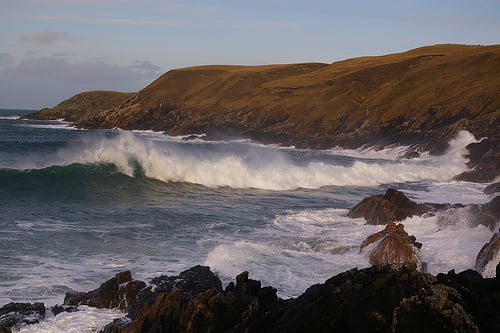

Economy
Scotland on track for 2020 renewables target
Scotland is now generating over a third of its electricity from renewable sources according to new figures published by the Department of Energy and Climate Change (DECC).
The statistics show that an extra 45% of renewable energy was generated in Scotland in 2011 compared to 2010, suggesting that if gross consumption stayed the same as in 2010, renewables will have accounted for 35% of the country’s electricity needs.
This surpasses the Government’s 2011 target of meeting the equivalent of 31% of Scotland’s electricity needs from renewables, staying well on track to reaching its impressive target of meeting the equivalent of 100% gross annual electricity demand from renewable energy by 2020.
In response to the figures, Scottish energy minister Fergus Ewing, said, “It’s official: 2011 was a record-breaker, with enough green electricity being produced in Scotland to comfortably beat our interim target.
“Projects representing £750m of investment were switched on in 2011, with an investment pipeline of £4 billion.
“Scotland is a genuine world leader in green energy and our targets reflect the scale of our natural resources, the strength of our energy capabilities and the value we place on creating new, sustainable industries.”
Indeed, with its mountainous landscape, blustery coastline and turbulent seas, it is not hard to see the full potential of Scotland’s natural geographic resources. Approximately 10% of Europe’s wave power is off Scotland’s coasts, and the country boasts 25% of Europe’s tidal stream potential and 25% of its offshore wind potential, according to the 2010 Offshore Valuation.
Feeding this appetite for clean power has been a hallmark of the SNP’s energy policy strategy since the party came in to power, with major renewables investments aimed at attracting further inward commercial scale private investment to stimulate further growth and jobs in the industry, while cutting carbon emissions.
This positive strategy has continued in to 2012, with the most recent of announcements on April 4 involving a 103-turbine onshore wind farm development in the centre of Shetland, an island north of the Scottish mainland famed for its uniquely breezy landscape.
Mr Ewing also highlighted other recent major developments, stating, “Since the turn of the year, we have seen Gamesa invest in Leith (Edinburgh) creating around 800 new jobs, the Green Investment Bank being headquartered in Edinburgh […] and Samsung Heavy Industries announcing it will base its £100 million European offshore wind project in Methil (Fife), creating up to 500 jobs.”
Other modes of funding have supported research and development aimed at improving the efficiency of offshore wind and marine renewable technologies. Blue & Green Tomorrow previously covered one such fund, where the overall aim is to bring marine renewable devices to commercial scale application. And at the community scale, early stage small-scale renewable energy projects are will be supported throughout Scotland by a recently announced £103m fund.
The continuation of such investment will help Scotland meet future renewables targets, crystalizing the nation’s position further as a global frontrunner in renewable energy.
The latest figures from DECC are particularly appropriate, coming just a day after experts told the Scottish parliament’s economy, energy and tourism committee that they did not think the ambitious 2020 target could be reached. In one case, Linda Greig, director of commercialisation and business development at Carnegie College, said that Scotland did not have the necessary skills base for achieving such a target in time.
Yet this view overlooks the current measures being implemented by the Government to create the skilled workforce needed to match projected growth in the renewables sector.
One Scottish government initiative, called the Low Carbon Skills Fund, is currently steered by the national careers and training body Skills Development Scotland (SDS) and already funds 50% of staff training costs for businesses and organisations working in low carbon technologies. The aim is to support the sustainability and growth of small-scale businesses by up-skilling and re-skilling employees. This kind of funding ensures that specific training and apprenticeships are already in place for an economy and labour market shifting increasingly away from fossil-fuel consumption towards clean, renewable energy.
A recent report by Scottish Renewables actually detailed the sizeable job power of the renewables sector, revealing that over 11,000 jobs are currently being provided directly by the industry. The scope for future growth and employment opportunity is massive too, and will be dependent on continued political support.
Much of the signs are optimistic, with first minister Alex Salmond pledging to speed up the renewables drive when a “re-industrialised” green economy was highlighted as one of his six practical steps to boost economic growth and jobs through independence, while alleviating future dependency on oil.
Scotland’s current drive for renewable energy reflects sustainable development, and the SNP government remains committed to ensuring that this will endure. These latest figures certainly show that the government is putting its money in the right place for both the economy and the environment – and we can be optimistic that similar investment will help meet future renewables targets from now until 2020.
If you would like to make the switch to fossil-fuel free energy, visit Good Energy—the UK’s only 100% renewable energy provider.
Further reading:
Scottish renewables fund to create “double positive effect”
Education key to achieving a “zero waste” Scotland
New wave of funding for marine energy sector
Ofgem likely to fund Scottish hook-up between renewable energy and grid


 Environment10 months ago
Environment10 months agoAre Polymer Banknotes: an Eco-Friendly Trend or a Groundswell?

 Environment11 months ago
Environment11 months agoEco-Friendly Home Improvements: Top 7 Upgrades for 2025

 Features9 months ago
Features9 months agoEco-Friendly Cryptocurrencies: Sustainable Investment Choices

 Features10 months ago
Features10 months agoEco-Friendly Crypto Traders Must Find the Right Exchange





























